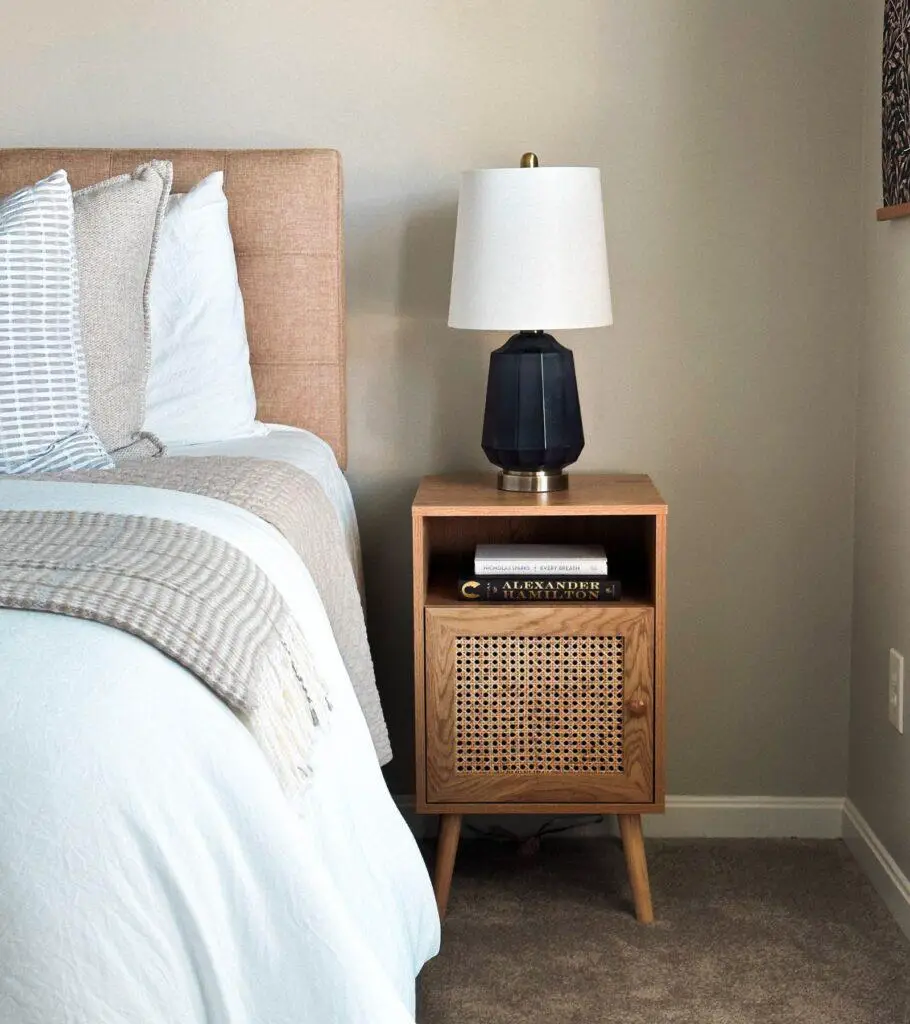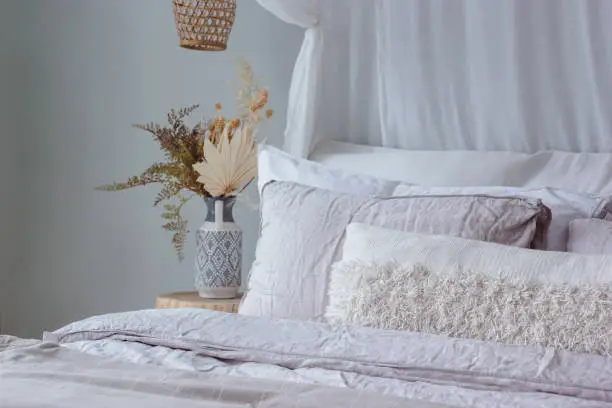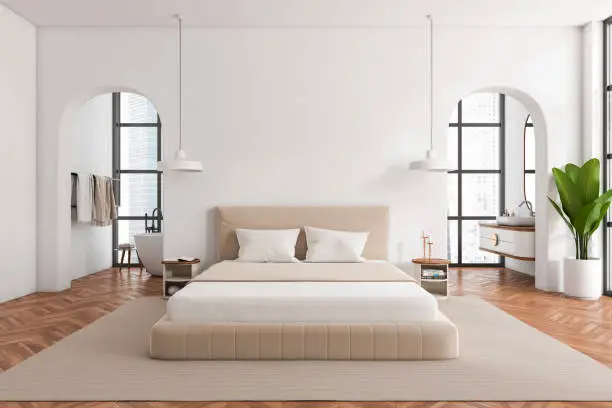
Selecting the perfect furniture for your bedroom involves more than just focusing on its appearance. It’s also about ensuring that your furniture matches the size and layout of your room. This is especially true when it comes to picking a nightstand, a piece of furniture that may seem relatively small but can actually have a substantial impact on both the functionality and the aesthetic of your space.
This guide is here to lend a helping hand, as we delve into the specifics of nightstand dimensions and offer advice on how to choose the perfect one for your bedroom. By understanding these dimensions and making a knowledgeable choice, you can enhance your room’s convenience, accessibility and overall visual appeal. Overlooking the size of your nightstand could derail your room’s style, but a well-chosen piece can tie everything together beautifully. So, let’s help you ensure a perfect fit!
Introduction to the Importance of Nightstand Dimensions
A nightstand, also known as a bedside table, is more than just an extra storage space or a place to keep your alarm clock. It’s a vital piece of bedroom furniture that can enhance the overall appearance and functionality of your room. The right nightstand height, width, and depth can make your room more comfortable and visually pleasing. But, it’s essential to choose the right dimensions so that it complements your bed and fits the available space perfectly.

Balancing Comfort and Functionality: Ideal Nightstand Heights
The height of your nightstand is an essential factor to consider. It should be roughly equal to the height of your mattress. This makes it easy to reach for your glass of water, phone, alarm clock, or any other item you keep on it. If the nightstand is too high, you might bump your head on it when getting up. On the other hand, if it’s too low, you’ll have to reach down, which can be uncomfortable.
As a rule of thumb, the ideal nightstand height should be 1″ or 2″ higher than the top of your mattress. However, this can vary based on the bed’s height. For instance, a standard bed frame height is 7″, box spring height is 9″, and mattress height is 10″. Adding these together gives a standard bed height of 26″. Therefore, the ideal nightstand height would be around 28″.
| Bed Height (in inches) | Ideal Nightstand Height (in inches) |
| 18-20 | 20-22 |
| 20-25 | 22-27 |
| 25-30 | 27-32 |
| 30-35 | 32-37 |
| 35 and above | 37 and above |
The chart shows how adjusting the height of your nightstand can aid in balancing comfort and functionality. Depending on the height of your bed, the height of the nightstand changes to ensure maximum comfort and accessibility.
The Significance of Nightstand Width and Depth
Getting the dimensions of your nightstand just right is a delicate balancing act crucial to achieving optimal functionality and aesthetics in your bedroom. A key player in this balance is the width of your nightstand.
Think about it: placing a large, wide nightstand next to a more modestly sized twin bed could potentially throw off the room’s sense of proportion, making the nightstand look awkwardly oversized. Conversely, installing a small nightstand next to a sprawling king bed could result in it seeming insignificantly tiny, virtually disappearing in the presence of the bed’s grandeur.
Your nightstand width should harmonize seamlessly with your bed dimensions and the available room space. For instance, paired with queen beds or modern platform beds, standard nightstands of moderate width work splendidly. However, when nestled next to king beds, opting for wider nightstands, 24 inches or larger, is recommended to maintain proportion and balance.
The depth of the nightstand is another defining factor. A deeper nightstand affords you ample space on the tabletop for bedtime essentials and even a bouquet of fresh flowers for that warming personal touch. It also offers increased storage room, always a beneficial feature to have for stashing away items to keep the surface clutter-free.
The perfect nightstand depth usually ranges from 16 to 20 inches. This applies across the board, irrespective of the size of the bed or the nightstand’s width. With this depth, your bedside companion strikes the right balance between providing a suitable surface area and not encroaching too much into your room space.
The nightstand dimensions play an instrumental role in dictating the room’s visual appeal as well as its practicality. Understanding these dimensions is critical, whether you’re redesigning your entire bedroom or simply refreshing it with new furniture pieces.
Influence of Room Size on Choosing Nightstand Dimensions
The dimensions of your bedroom significantly influence the selection of your nightstand and other bedroom furniture such as your bed, dresser, or end tables. The secret to achieving a beautiful and functional bedroom lies in the art of striking a delicate balance amidst these furniture pieces.
Take, for instance, a spacious room paired with a comparatively small bed. Here, you might opt for a nightstand with a larger width to occupy the extra space in the room. This generous width of the nightstand serves a dual purpose – it not only offers more surface area for use but also helps maintain visual balance in the room, ensuring your bed doesn’t seem adrift in a sea of space.
On the contrary, let’s visualize a small room housing a king-sized bed, which fills most of the floor space. In such a scenario, an oversized nightstand would make the room feel overcrowded. Instead, you should consider a nightstand of smaller width, possibly closer to the standard size. Such a nightstand ensures that you have just enough space for your essential items without encroaching too much into the already limited room area.
In essence, the careful consideration of the size of your room and the dimension of other furniture pieces, in relation to your nightstand, plays a pivotal role in creating a balanced, serene, and functional sleeping space. It’s all about accommodating your needs and lifestyle without compromising on aesthetics and comfort.

Material and Style Considerations in Nightstand Dimensions
The dimensions of your room play an instrumental role in determining the optimal nightstand size, a critical piece in your suite of bedroom furniture. For instance, suppose you possess a spacious room housing a smaller-size bed. In that case, you may require a larger-width nightstand that adds substance and fills up the extra space, creating a more harmonious and well-proportioned room aesthetic.
However, in contrast, if your floor plan leans more towards the cozy and quaint side, paired with a king-size bed, a smaller, more modestly sized nightstand might be your best bet. This would prevent your bedroom from feeling claustrophobic or overly stuffed, maintaining a sense of free movement and space.
The width of your nightstand is crucially important in achieving this balance, contributing not only to the coherence of your style but also the functionality of your room’s layout. The standard sizes of nightstands, often paired with dressers and end tables, may not be the perfect fit for your unique space.
In essence, the voluminous dimensions of larger rooms render them more forgiving of larger furniture pieces, whilst smaller rooms often require careful consideration to ensure they don’t end up feeling congested. Carefully weighing how much space you have available against the physical size of the furnishings can help you select the most suitable Nightstand dimensions for your room. Creating an environment that is as practical and easy to navigate as it is visually stunning.
Safety Considerations when Choosing Nightstand Dimensions
Safety should unquestionably join aesthetics and functionality on your list of considerations when it comes to selecting your nightstand’s perfect dimensions. The height of your nightstand, for example, can pose unexpected risks if not appropriately chosen.
Imagine a nightstand that towers too high beyond your mattress level; it could potentially become a hazardous point of contact, especially for energetic children buzzing around the space. It could easily cause unintended head bumps or bruises.
Conversely, think of a nightstand positioned too low. Consistently having to reach down for your alarm clock, reading glasses, or bedtime book might not seem like much, but repeatedly performing this awkward movement can strain your back over time, possibly leading to persistent discomfort or backaches.
It becomes clear, then, that achieving the right balance is crucial. The most suitable nightstand for you would be one with dimensions that align seamlessly with your bed and mattress height.
The goal should be creating a smooth, level reach from the bed to the nightstand top, providing accessible and safe contact to its surface and contents. This ensures an effortless grab for your essentials during the night, all while keeping the room aesthetically pleasing and functionally efficient.

Utilizing the Proper Nightstand Dimensions to Enhance Bedroom Aesthetics
Choosing the appropriate nightstand dimensions is essential to amplifying the aesthetic appeal and functionality of your bedroom. A nightstand that mirrors the proportions of your bed and fits harmoniously within your room’s dimensions serves to create a visually balanced and exquisitely designed space.
The correct size nightstand acts like a well-tailored piece of clothing, accentuating the bedroom’s positive features and making it look as spacious and comfortably chic as it can be. This becomes particularly crucial when dealing with a small space, where every furniture choice impacts the overall feel and usability of the room.
Incorporating a nightstand that works well within the limited space constraints can be a game-changer. It goes beyond just being a standing piece — it becomes a functional haven for your bedtime essentials, a personal podium for your preferred reading material, or a display spot for treasured keepsakes.
And beyond dimensions, the material of your nightstand also plays a vital role. A good quality, solid wood nightstand, for instance, not only brings a warm and natural aesthetic to your bedroom but also adds a durable, long-lasting component to your space.

Conclusion
Choosing the right nightstand dimensions is crucial for functionality, comfort, and aesthetics. Take into consideration the size of your bed, the available space, and your needs to find the perfect nightstand for your bedroom. Remember, the most important thing is that the nightstand works for you and fits into your space seamlessly.
